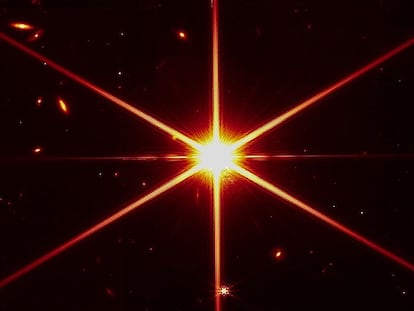Where is the closest black hole to Earth?
While none exist in our solar system, the Milky Way galaxy may be home to millions of them

There are three kinds of black holes: stellar, intermediate and supermassive. Stellar black holes are the smallest, and they are born from the death of stars – but only the largest of stars: our sun won’t turn into a black hole. These smaller black holes can be found relatively close to the Earth. While intermediate and supermassive black holes are very far away, in the centers of other galaxies, stellar black holes exist within our own galaxy.
Stellar black holes have about a dozen times the mass of the Sun, while intermediate ones are hundreds to thousands of times bigger, and supermassive black holes can be up to a billion times larger. These objects are found in the centers, or close to the centers, of almost all kinds of galaxies, regardless of the type of galaxy.
Black holes are impossible to see. They can be detected indirectly through their interaction with space and the material around them. Scientists have several techniques to detect the locations of black holes. The search begins by locating phenomena that can be caused by black holes, such as high-energy jets, then studying whether it could be due to a black hole.
Several years ago, what was thought to be the closest stellar black hole ever discovered was detected. The object, named “The Unicorn,” is more than a thousand light-years away, meaning that it would not have any effect on the Earth. Contrary to popular depictions, black holes are not magnets that attract everything: they only affect objects within what is called their radius of influence, or the apparent radius of the event horizon. But The Unicorn turned out to be an optical illusion. The closest confirmed black hole is, in fact, almost 5,000 light-years away. Though our solar system has no black holes, the Milky Way is full of them. Scientists estimate that our galaxy may be home to millions of black holes.
As for supermassive black holes, there is usually only one in each galaxy, typically in the center. Researchers believe that black holes and galaxies grow alongside each other: the larger the galaxy, the larger its black hole. The closest supermassive black hole is the one at the center of our own Milky Way galaxy, Sagittarius A*, some 50,000 light-years away.
So far, no intermediate black holes have been measured. Some exist within our galaxy, but they currently pose a great enigma. Primordial galaxies were once much smaller than those that exist today, so given the existing theories on black holes, they likely contained intermediate black holes. Over time, these small galaxies interacted and collided with each other, forming larger ones. The same happened with their black holes, leading to the formation of supermassive black holes. It is important for scientists to detect intermediate black holes, as they are the missing link between stellar and supermassive black holes.
Anna Ferré-Mateu has a PhD in astrophysics and is a researcher at the Canaries Institute of Astrophysics (IAC).
Question sent via email by Luis Fernando Pérez Sicacha.
Tu suscripción se está usando en otro dispositivo
¿Quieres añadir otro usuario a tu suscripción?
Si continúas leyendo en este dispositivo, no se podrá leer en el otro.
FlechaTu suscripción se está usando en otro dispositivo y solo puedes acceder a EL PAÍS desde un dispositivo a la vez.
Si quieres compartir tu cuenta, cambia tu suscripción a la modalidad Premium, así podrás añadir otro usuario. Cada uno accederá con su propia cuenta de email, lo que os permitirá personalizar vuestra experiencia en EL PAÍS.
¿Tienes una suscripción de empresa? Accede aquí para contratar más cuentas.
En el caso de no saber quién está usando tu cuenta, te recomendamos cambiar tu contraseña aquí.
Si decides continuar compartiendo tu cuenta, este mensaje se mostrará en tu dispositivo y en el de la otra persona que está usando tu cuenta de forma indefinida, afectando a tu experiencia de lectura. Puedes consultar aquí los términos y condiciones de la suscripción digital.










































